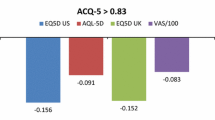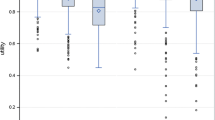Abstract
Objective: The primary objective was to evaluate the relationship between willingness-to-pay (WTP), quality-of-life (QOL), and disease-severity measures in patients with asthma. The hypothesis studied was that patients with asthma with more severe disease are willing to pay more for a hypothetical cure of asthma than those with less severe disease.
Design setting/Patients and participants: One hundred patients with asthma were recruited from community pharmacies in Kentucky for 30-minute face-to-face interviews.
Interventions: Spirometry assessed objective disease severity in terms of pulmonary function, while a multiple choice question measured subjective disease severity. The Medical Outcomes Study 36-item Short Form (SF-36) health survey and Asthma Technology of Patient Experience (Asthma TyPE) measured quality of life. WTP was obtained via a dichotomous choice contingent valuation question.
Results: In this exploratory evaluation, WTP was significantly related to both objective disease severity (p = 0.02) and subjectively assessed disease severity (p = 0.01). For objective disease severity the mean monthly WTP was $US90 for mild asthma, $US131 for moderate asthma and $US331 for severe asthma and for subjective disease severity the mean monthly WTP was $US48 for mild asthma, $US166 for moderate asthma and $US241 for severe asthma.
Conclusions: The results suggest that the WTP for a cure from asthma is related to both objective and subjective disease severity. These findings contribute to the case for construct validity of the dichotomous choice contingent valuation method in the healthcare sector.









Similar content being viewed by others
References
Johannesson M. Theory and methods of economic evaluation of health care. Boston (MA): Kluwer Academic Publishers, 1996
Mitchell RC, Carson RT. Using surveys to value public goods: the CV method. Baltimore (MD): John Hopkins Press, 1989
Reardon G, Pathak DS. Contingent valuation of pharmaceutical and pharmacy services-methodological considerations. J Soc Adm Pharm 1989; 6: 83–90
Diener A, O’Brien B, Gafni A. Health care contingent valuation studies: a review and classification of the literature. Health Econ 1998; 7: 313–26
Elixhauser A, Halpern M, Schmier J, et al. Health care CBA and CEA from 1991–1996: an updated bibliography. Med Care 1998; 36: MS1–9
O’Brien B, Goeree R, Gafni A, et al. Assessing the value of a new pharmaceutical: a feasibility study of contingent valuation in managed care. Med Care 1998; 36: 370–84
O’Brien B, Viramontes JL. WTP: a valid and reliable measure of health state preference. Med Decis Making 1994; 14: 289–97
Blumenschein K, Johannesson M. Relationship between quality of life instruments, health state utilities, and willingness to pay in patients with asthma. Ann Allergy Asthma Immunol 1998; 80: 189–94
Stavem K. Willingness to pay: a feasible method for assessing treatment benefits in epilepsy? Seizure 1999; 8 (1): 14–9
Zethraeus N, Johannesson M, Henriksson P, et al. The impact of hormone replacement therapy on the quality of life and willingness to pay. Br J Obstet Gynaecol 1997; 104 (10): 1191–5
Narbro K, Sjostrom L. Willingness to pay for obesity treatment. Int J Technol Assess Health Care 2000; 16 (1): 50–9
Kartman B, Andersson F, Johanneson M. Willingness to pay for reductions in angina pectoris attacks. Med Decis Making 1996; 16 (3): 248–53
Chestnut LG, Keller LR, Lambert WE, et al. Measuring heart patients’ willingness to pay for changes in angina symptoms. Med Decis Making 1996; 16 (1): 65–77
Lundberg L, Johannesson M, Silverdahl M, et al. Quality of life, health-state utilities and willingness to pay in patients with psoriasis and atopic eczema. Br J Dermatol 1999; 141 (6): 1067–75
National Oceanic and Atmospheric Administration. Report of the NOAA panel on contingent valuation. Fed Regist 1993; 58: 4602–14
Stewart AL, Hays RD, Ware JE. The MOS short-form general health survey: reliability and validity in a patient population. Med Care 1988; 26: 724–35
Bousquet J, Knani J, Dhivert H, et al. Quality of life in asthma. I. Internal consistency and validity of the SF-36 questionnaire. Am J Respir Crit Care Med 1994; 14 (2 Pt 1): 371–5
Asthma TyPE, Health Outcomes Institute, 1994
National Institutes of Health. National Heart, Lung, and Blood Institute. Guidelines for the diagnosis and management of asthma: NAEPP expert panel report 2 [online]. Available from URL: http://www.nhlbi.nih.gov/guidelines/asthma/asthgdln.htm [Accessed 2002 Mar 8]
Cameron TM. A new paradigm for valuing non-market goods using referendum data: maximum likelihood estimation by censored logistic regression. J Environ Econ Manage 1988; 15: 355–79
Greene WH. Econometric analysis. 2nd ed. New York (NY): Macmillan, 1993
Newbold P. Statistics for business and economics. 3rd ed. Englewoods Cliffs (NJ): Prentice-Hall, 1991
Juniper EF, Guyatt GH, Ferrie PJ, et al. Measuring quality of life in asthma. Am Rev Respir Dis 1993; 147: 832–8
Apter AJ, Reisine ST, Affleck G, et al. The influence of demographic and socioeconomic factors on health-related quality of life in asthma. J Allergy Clin Immunol 1999; 103: 72–8
Juniper EF, Guyatt GH, Epstein RS, et al. Evaluation of the impairment of health-related quality of life in asthma: development of a questionnaire for use in clinical trials. Thorax 1992; 47: 76–83
Acknowledgements
The authors would like to acknowledge the pharmacists who assisted with recruitment in this study (listed in alphabetical order): Jennifer Barker, Leon Claywell, Corky Edwards, Gary Hamm, and Joe Nobrega. This study was funded by the American Association of Colleges of Pharmacy New Investigator Award, which is supported by The Burroughs Wellcome Fund and the American Foundation for Pharmaceutical Education.
Author information
Authors and Affiliations
Corresponding author
Rights and permissions
About this article
Cite this article
Zillich, A.J., Blumenschein, K., Johannesson, M. et al. Assessment of the Relationship Between Measures of Disease Severity, Quality of Life, and Willingness to Pay in Asthma. Pharmacoeconomics 20, 257–265 (2002). https://doi.org/10.2165/00019053-200220040-00004
Published:
Issue Date:
DOI: https://doi.org/10.2165/00019053-200220040-00004




